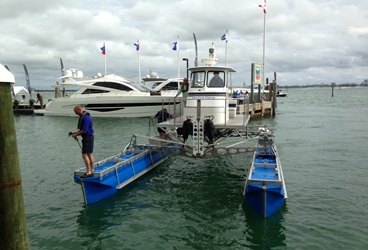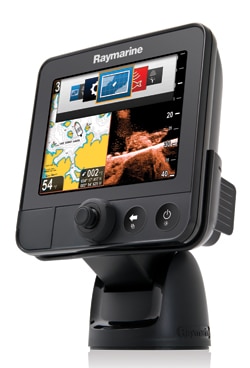
Velodyne
Before I get into the meat of this post, I want you, dear reader, to understand that I know who you are, and why you read Cruising World magazine and its associated websites. You’re sailors. Sailors who cruise. I get it. But I also understand that you’re people of the sea, and that most things (well, alright, probably not jetskis and go-fast powerboats) that float upon the sea are of no small interest to you. You want to know what ship that is, where that fishing vessel is headed, and what channel that dredge is working. That’s why I took a ride today on, by far, the most interesting-looking vessel of the entire boat show, the Velodyne 1.5.
As you can see from the picture I took, the Velodyne is, most assuredly not a sailing vessel. But what the heck IS it? Well, basically it’s a simple, utilitarian platform devoted to a small pilothouse and a seating area mounted on two pontoons. It looks ungainly and a bit agricultural, but that’s OK, because it’s a proof-of-concept vessel. Look carefully at the system which supports the platform and you’ll see pistons, airbags, and associated gear. What all the pneumatic devices and milled aluminum bits do is provide a stable platform no matter the condition of the sea surface. Waves? Stable. Vessel wake? Stable. A processor senses the sea conditions, assesses the motion, and instantaneously sends signals to four pneumatic piston/airbag combinations that quickly counteract the motion and keep the pilot/passenger area stable.
The Velodyne concept is the brainchild of David Hall, a prolific inventor who, before getting involved in the marine industry, created audio systems and worked on robotics and computers, as well as servos, optics, and lasers. He is widely known as the man behind the Light Detecting and Ranging (LIDAR) 3-D mapping system that allows the famous un-manned Google cars to drive about without human interaction. The Velodyne 1.5 carries one of the $200,000 LIDAR systems, and I can promise you, that in the not-too-distant future, you’ll be seeing these systems on boats. The image created on the screen by the million-plus per-second laser pulses is incredibly clear, and works extremely well at night or in poor visibility conditions. It’s not ready for primetime yet, but soon…
So, how was the ride? Stable. A little wet, as they’re still sorting out how to direct spray from around the hulls, but more than anything else, stable. The hulls move up and down with the wakes and waves, but the servos hum, the pistons move, and the platform stays stable. Because the system uses air (pneumatics) instead of hydraulics, it reacts far more quickly and uses far less power. Possible uses? Probably not sailboats, folks, sorry, but who knows? I can almost guarantee that, if the money holds out, and the word spreads, that you’ll be seeing more of this type of vessel being used for water taxis, ferries, and workboats. The appeal of a stable platform no matter the sea conditions appeals to all of the above. And what good does that do the CW reading population? Well, when you see one go by, you’ll be able to nod wisely and explain to your crew exactly what they’re seeing and how it works. www.velodynemarine.com
To carry on in today’s tradition of steering clear of anything with a mast or sails, I also took a ride on a small, center-console sportsfishing boat to check out the latest fishfinder from Raymarine, the Dragonfly. By now you’re thinking that I’ve completely lost my editorial focus, yes? Nope. Like most of you, I look at today’s latest technology, even if it isn’t dedicated to the cruising sailor, and see what we may be seeing in the future. Imagine gunkholing in poorly charted waters in the Exumas, or the San Blas islands and feeling confident in your ability not to pile your boat onto the hard bits that nobody’s bothered to chart, but are nonetheless still there. That’s what this latest generation of fishfinder will someday do for us. Instead of that fuzzy, multihued image that you see on even the best of today’s fishfinders, what you see with the Dragonfly is a crisp image with an almost three-dimensional feel to it that gives you a very clear idea of what’s under the water.
Powered by Raymarine’s widely hailed CHIRP technology, which has been around for a year, the Dragonfly uses two types of sonar imaging. The first, a standard conical signal, reveals a crisp, but typical fishfinder-y image. Great if you feel like casting a lure out or snagging a net full of bait. The second image is created by a fan-type beam, which ranges out to 60 degrees from centerline and is 1.4 degrees wide. This beam reveals what truly lies on the bottom. Unlike typical fishfinders, it gives you confidence in what you’re seeing. While this new release is meant for fishermen working in freshwater or near-coastal areas, mostly because of the transom-mounted transducer, plans are in the works for a through-hull transducer. Mount one of these forward of your keel, proceed slowly, and you’ll be able to pick your way through poorly charted rock gardens and find that perfect anchorage that only the locals once knew how to safely access.

The Dragonfly features a 5.7-inch screen with a very bright 1500-nit display, and uses only three buttons for control, making the user interface dead simple. It also has a GPS, and is, naturally, a chartplotter, which uses Navionics charts. Right now, the unit, all-up, but without charts, starts at $649. I expect that even with a hull-mounted transducer, the future Dragonfly will come in well under $1,000, and may well become an important part of your off-chart exploration.
I’ll get back to the more CW-brand specific electronics I saw at the show on Monday, I promise.








